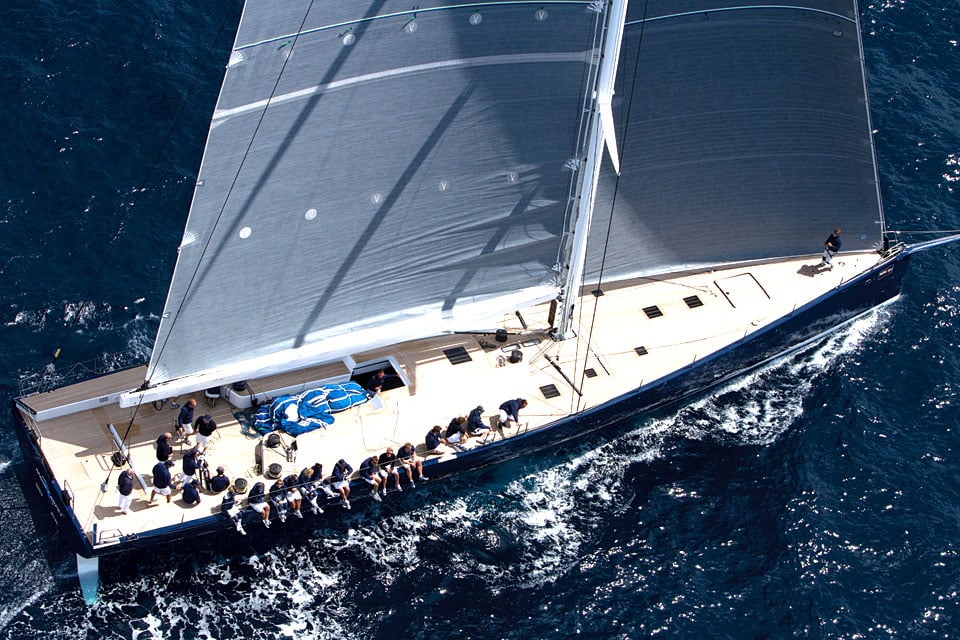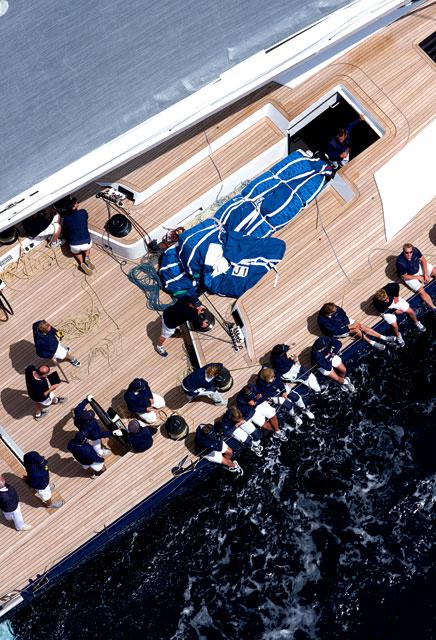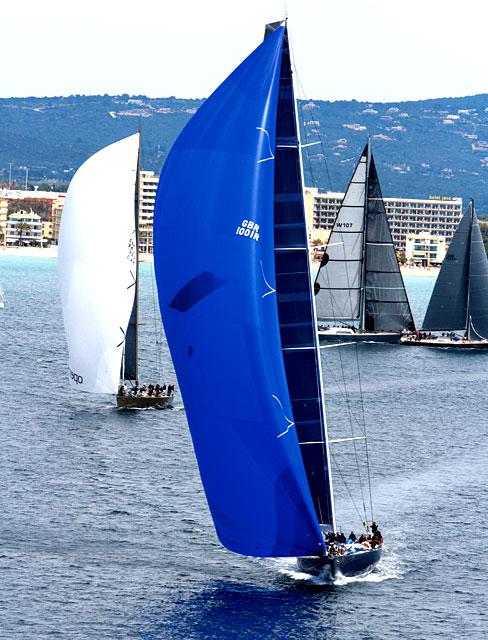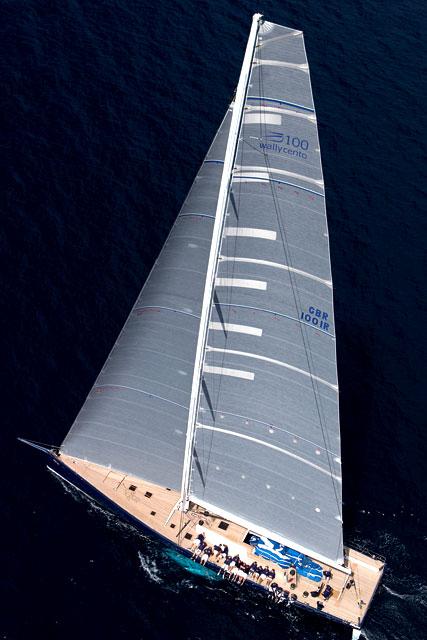
Wally Cento Magic Carpet 3
A decade ago it was impossible to mistake a Wally design, those queens of the superyacht scene with their expansive and barren teak decks, low-profile deckhouses, cockpit couches, and beamy, aggressive hull lines—aggressive at least for the traditionalists of the Mediterranean yachting set. Beneath those decks were lairs of modern luxury, but when it comes to racing, luxury doesn’t usually equate to lightweight. As eye catching as they were (and still are), when the Wallys of old came out to play among the handicap grand-prix set, they usually struggled.
The stakeholders at Wally Yachts have since reintroduced the brand with what’s called the Wally Cento box rule, which encourages lighter designs while retaining the distinctive Wally look and interior requirements. The newest Wally Cento 100 is Magic Carpet 3, a Reichel/Pugh design with a combination of high life and high performance. It’s good looking, and it isn’t slow, either. Only two weeks after its May 2013 launch, Magic Carpet 3‘s owner, Sir Lindsay Owen-Jones, of England, entered it into the Gaastra PalmaVela Regatta in Mallorca, Spain, and swept class line honors, finishing between five and 20 minutes ahead of its closest competitor. At this summer’s Maxi Yacht Rolex Cup it even took a few light-air races, which pleased its project manager, Bob Wylie, a veteran of the grand-prix game.
“The Wally Cento was created to give the owners a Wally with more performance and more excitement with square-top mainsails, bowsprits, and big-size gennakers … a bit more bang for their dollar,” says Wylie, who oversaw the boat’s two-year build. “It’s a pretty powered up package that, in 15 knots, actually feels like a proper grand-prix raceboat.”

The Wally Centos, of which two have been built and a third is underway, are built to the Wally Class rules, which have a 50-ton maximum weight and the same interior requirements with regard to the accommodations. Using lighter materials and better sail control systems, however, has allowed the boats to be livelier than earlier Wally builds.
Onboard Magic Carpet 3, Owen-Jones, a longtime racing owner, preferred a minimal interior, which consists of an owner’s cabin, two guest cabins, a crew cabin—each cabin has its own head—a salon, and a galley. Wylie says they worked in conjunction with the Reichel/Pugh office to be more aggressive with perfecting the hull lamination in order to make it more advanced all around. The hull is a pre-preg carbon/Nomex composite.
“The interior furniture, made as light as possible, has no play on the structural side of the boat,” says Wylie. “The bulkheads provide all the structure, and the interior is just modules that pop right into the boat. Basically the interior was assembled in another factory in a mock-up, taken apart, and put in. You could take it all out just as easily. It’s all pieced together. The big challenge in the boat is the hydraulic systems because hydraulic pumps drive everything: the propulsion, the keel lift, the cylinders, and the winches.”
In developing the boat, which is used primarily for racing and one extended cruise per year, the next step, says Wylie, was to develop a spar and sail inventory package that had easy and reliable systems.
“When we looked at the sail inventory, sail handling was very important,” he says. “Handling them during a race, for example, we had to determine if we’d have enough time to pack spinnakers upwind. It’s a pretty complex exercise to figure out what sails to build and how to handle them and treat them onboard. So there are lots of little areas we had to look at to sail the boat better and save weight.”

In doing so they kept to the Wally approach by keeping the deck layout clean and simple. “We tried as hard as possible to minimize what the naked eye could see at the dock,” says Wylie. “Everything we could hide, we did.” For example, the soft padeyes have their strops below deck level, the stanchions sit in the chamfer of the sheer, no pins are visible for the spinnaker sheet blocks, and the mainsheet cylinder is in the bilge underneath the owner’s bunk.
To design and engineer the hydraulic system, they did a mockup of the engine room to make it workable and serviceable, and then ran all the piping in the bilge in the early stages of construction so when the structure was built all the penetrations were already in the structure. This made for a clean and easy installation. “We did a lot of 3D modeling as well,” says Wylie, “which allowed us to get a good view of the boat and how it all goes together.”
In terms of the sail handling, they worked on reefing systems and developed the headsail crossovers so they didn’t have too many sails in the inventory. In the spinnaker quiver, there’s an A1 and A2, which are wooled for racing, and a Code Zero and A3, which are kept on furlers. The A4, the boat’s biggest spinnaker at 960 square meters, is kept on a top-down furling unit. “It’s the only way to deal with that one—it would have been impossible to get it down and repacked in a two-mile beat.”
Because the class doesn’t allow string-drop systems, all spinnakers go down the hatch. Drop lines run across the deck, and the spinnaker gets gathered above the hatch while a couple of crew down below pull it into the salon. “We did one pack in Sardinia in four and a half minutes with five guys—that was pretty impressive. But it’s usually about six minutes with five guys.”
For headsails the boat has a J1, J2, and J3, which covers them up to 25 knots of breeze. They’re all set on soft hanks because the headsail foil that would have been used over the EC6 composite forestay would have been much too big. “We have good crossovers so we can basically choose just one before the race or the day and that’s it,” says Wylie. “In offshore-race mode we have a J4, which is like a solent. It’s set a couple of meters behind the forestay and goes to the top spreader. That’s on a furler, so if you ever need to do a sail change you pop that up and go for the maneuver.”

Wylie has been involved with numerous top-end programs including the 100-footer Speedboat/Rambler and says some of the rig experiences from that boat were brought into Magic Carpet‘s Southern Spars package. “We pushed to have a deflector lower on the mast, which gives us a bit more overall control of the whole spar,” he says, “and we have locking systems on everything, including reef locks, and lazy jack systems.”
As simple as the boat may appear on the outside, the intricacies of the boat’s systems do present unique challenges on the racecourse, especially, says Wylie, when it comes to matching human input to computer-automated controls. In the boat’s three major regattas thus far, the sailing team has managed the learning curve well, but it hasn’t been perfect. “We’re getting better,” says Wiley. “The challenge with a new boat like this is dialing in the PLC logic [essentially, the microprocessor and software that allow all the various systems to talk to each other] and getting all the functions working how you want them to work, which correlates to how you do the crewwork with the maneuvers.”
The winch speeds, for example, are preset to what the crew can tail comfortably by hand. Then there’s a manual overdrive on each gear, which speeds up the winch in that gear. “If you have a rope in a self-tailer, you can go to first gear to get it going,” Wiley explains. “It really helps with some of the maneuvers like jibes or spinnaker hoists. But there’s a balance of finding what people are comfortable doing by hand and watching what the sail is doing so you don’t break the sail. If you go too fast, you can cause some serious damage.”
The Wally rule requires that the boat be able to tack automatically as well (useful when shorthanded cruising), so they’ve had to work on logic for the backstay cylinders. With a push of one button, the new backstay can be tensioned and the other eased during a tack. The traveler can be tacked automatically as well, which is essential for the owner, of course, because when the race team of 24 crew is not on hand to push the buttons and pull the strings, the boat, with all its state of the art luxury and performance, is still a superyacht.
This article first appeared as Tech Review: Beneath the Teak, in the November/December 2013 issue of Sailing World.









